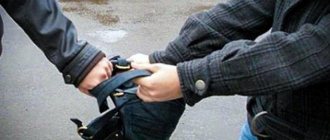Important! If you are handling your own theft case, you should remember that:
- Each case is unique and individual.
- Knowledge of the laws is desirable, but does not guarantee a solution to your particular problem .
- The possibility of a positive outcome depends on many factors .
Get a free consultation with a lawyer with the support of the Ministry of Justice of the Russian Federation
When police receive a report of a theft, one of the key initial actions is to investigate the crime scene. The positive result of the search for the criminal and the stolen items or money largely depends on the timeliness and correctness of this procedural event.
Forensic characteristics of burglaries
When qualifying theft from apartments or other residential premises, the general and specific rules of Art. 158 of the Criminal Code of the Russian Federation. Theft is characterized by the following nuances:
- the offender will be punished even if the total amount of damage does not exceed 2,500 rubles (for a smaller amount, punishment is applied only under the Code of Administrative Offenses of the Russian Federation);
- the degree of punishment is influenced by the method of theft, as well as the amount of damage caused;
- the value of valuables or the amount of stolen money is determined based on the results of forensic examinations;
- To correctly qualify residential burglary, a gradation of the amount of damage is used according to one of the parts of Art. 158 of the Criminal Code of the Russian Federation - significant, large and especially large.
The item could be any movable property or money to which the offender had no legal right. For example, if one’s own things that are temporarily in the possession of other persons are secretly stolen, liability will arise not for theft, but for other illegal actions (for example, arbitrariness). Likewise, if items or money were stolen by a tenant who has a legal right to enter and reside in the apartment, there will be no indication of a break-in or unlawful entry.
Secret theft of valuables or money from citizens’ homes will be considered under Part 3 of Art. 158 of the Criminal Code of the Russian Federation. The maximum penalty for such an offense will be imprisonment for a term of up to six years. At the same time, the method of entering an apartment or private house does not have any legal significance; for liability to occur, it is important to prove that the criminal does not have the legal right to enter the premises.
Concept
Pickpocketing is the most common form of property crime. The essence of the offense is the theft of the victim's property from pockets or carry-on luggage. The item can be any value: money, phones, wireless headsets, bank cards, jewelry.
Pickpocketing is a crime committed only with intent. In most cases, the motivation of a thief is personal enrichment: stealing money or an expensive item for the purpose of selling. However, some criminals commit crimes for the sake of adrenaline or entertainment. They are not so much interested in property as in the thirst for “thrills.” However, the motive does not negate the fact of theft, which means that it will not be possible to avoid responsibility for crimes of this kind.
The situation in which burglaries occurred
Since the corpus delicti implies the secret nature of the thief’s actions, the moment of the theft can only be determined by accident or after a long time:
- traces of breaking into doors or windows may be noticed by random witnesses or neighbors in the entrance;
- You can discover the loss after returning from vacation or a long departure;
- An alarm may sound if the facility is armed.
A professional criminal may not leave obvious signs of a break-in by using key impressions, unlocked windows and vents, etc. With such actions, the fact of theft may not be established even when the owner returns to the apartment.
Let us highlight the characteristic features of theft from residential premises:
- the criminal makes preliminary preparations - establishes the period of departure or absence of the owners from the apartment, finds out whether the residents have potentially expensive equipment, valuables or a large sum of money;
- at the moment of entering an apartment and leaving the crime scene, the thief is most vulnerable, therefore the theft occurs during the daytime (when most citizens and neighbors are at work) or at night;
- The help of accomplices is often used - while the thief enters a residential area, accomplices distract the attention of bystanders or signal the danger of detection.
The above circumstances will be established during the investigation. Even if there are no witnesses, neighbors or passersby can talk about increased attention to the apartment or its owners, as well as suspicious actions of strangers.
Pickpocket Methods
There are many methods of pickpocketing. It is simply impossible to provide the entire list. In addition, law enforcement officers regularly encounter new and improved methods. Let's consider methods that are considered classics in practice.
Method number 1: distraction. Used by a group of thieves. They find a victim in the crowd, after which one of the attackers approaches the person with a trivial question. For example, with a request to tell you where an object is located. While the victim explains the way, the second attacker robs her. Finding such criminals is difficult.
Method number 2: hot tea. Can be used by one attacker. Instead of tea, there may be another hot drink or food that is guaranteed to stain the victim's clothes (for example, a hot dog with ketchup). The thief accidentally spills hot tea on a passerby or cafe visitor and, apologetically, rushes to help eliminate the consequences. But at this time deft hands are already examining pockets in search of valuables.
Method number 3: “Let me help you.” An offer to help grandma cross the road is not always good. For example, an attacker offers to help you down the steps. While you are going down, your pockets and purse are carefully examined for items of interest to the thief.
Method number 4: “Whose money?” Practiced in a group. One of the attackers throws a bill on the ground and addresses the victim, pointing out that she has lost money. While the victim is picking up the bills, an accomplice emerges from the crowd and claims that the money is his. While a person is arguing with an accomplice of a criminal, nothing prevents the thief from taking everything more or less valuable from his pockets.
There are also dozens of methods to remove a wallet from your pocket. The most common of them is practiced in transport or in a crowd. If a pickpocket notices that the edge of the victim's wallet is sticking out of his pocket, he calmly approaches her, grabs the wallet with two fingers and smoothly pulls it out, after which he slowly leaves.
Another method is also mainly used in crowds, especially in transport. The attacker approaches the victim from behind and positions himself near the pocket with the wallet. At the right moment, he gently pushes the wallet so that the edge of the wallet comes out of his pocket. The victim moves away, and the wallet, picked up by the pickpocket, remains in his hands.
Typical signs of burglary
The fact of entry into a residential area and removal of valuables or money can be detected by both the owner of the apartment and a random witness (neighbor, acquaintance, relative, etc.). Typical signs of burglary are:
- open doors with or without traces of locks being broken, the door leaf being pressed out;
- broken windows or vents, broken doors;
- scattered things or other traces of the criminal’s departure.
If visible traces of a crime are found, it is not recommended to enter the residential premises on your own. In this case, you may encounter a criminal, which will result in harm to health, or there is a possibility of losing important evidence for the investigation. In addition, a citizen who discovers the fact of a break-in in a residential premises may be accused of committing a crime if he decided to enter the apartment and left his traces.
In these cases, it is better to immediately contact law enforcement officers and tell them about a possible crime. Such oral or written reports will not be considered a false report, even if the theft is not confirmed.
To get the most detailed advice on your issue, you just need to follow any of the suggested options:
|
Subsequent stage
Investigative and operational actions require employees to thoroughly prepare the ground, study the identities of the participants in the case, and find the moment to carry out work. Features in the theft investigation process are taken into account at each stage.
If all the necessary data is available, the guilty party is found guilty, and the existing episodes are proven, all that is required is to verify the testimony. If a person does not want to admit guilt, but the evidence is sufficient for the prosecution, then it is necessary to refute the arguments put forward as a defense. If the accused admitted guilt, but the evidence base is small, then it is necessary to select a written record of what was said and collect the missing information.
When there is no evidence, guilt is not recognized, in this situation information is collected, and subsequently guilt is presented to the defendant. The most difficult situation arises when there is evidence of one episode, and witnesses report others.
The investigator/interrogator carries out:
- confrontations;
- examination;
- identifications, which are designed to collect evidence.
Interrogation of the accused
The absence of conflict during interrogation arises only if guilt is admitted and truthful testimony is given.
In case of partial recognition, the following is established:
- What action took place?
- How and to what extent.
The case is built on the information already collected.
Confrontation
Confrontation within the framework of a case is an opportunity to eliminate contradictions between participants in the process. It is carried out when the victim, the accused and witnesses report different facts and circumstances. The goal and tactics are determined independently, and sometimes the collected data is demonstrated.
This way it is easy to determine:
- type of stolen;
- value;
- time of crime;
- size of the stolen item.
Checking readings on site
The next stage contains the need to verify and clarify the received evidence.
The police are checking:
- Circumstances.
- Awareness.
- Compliance with previously given indications.
Forensic examinations
Forensic examination is part of a criminal case.
Kinds:
- traceological;
- fingerprint;
- chemical;
- merchandising;
- materials science and others.
The attacker overcomes a number of obstacles before committing the act, always leaving traces.
The methodology for investigating thefts in forensic science allows them to be identified and attached to the case materials.
Protocol for Inspection of the Scene of Incident in Theft Cases
Inspection of the scene of the incident is one of the mandatory operational-search actions after receiving a statement from the victim. Police officers are given three days to conduct a pre-investigation check, and an inspection of the apartment will allow them to record many traces of the crime and evidence in the criminal case.
The following circumstances are established:
- method of entering the premises and leaving with stolen things;
- possible instruments of crime with the help of which the break-in occurs - a master key, original or duplicate keys, an ax, a crowbar, etc.;
- data on the number of attackers, their professional criminal skills, gender and age characteristics;
- information about stolen items or funds - the value of the property and the amount of money, a list of stolen items, etc.;
- time of entry into the apartment and theft;
- other circumstances that will be important for the investigation of the case.
Note!
During the pre-investigation check, the fact of the crime itself is established. To do this, a circle of people who had access to the home and knew about the presence of valuables and funds is determined.
Also, when inspecting the scene of the incident, the fact of a possible staged theft will be checked (for example, to conceal the embezzlement of funds or for other reasons).
The results are recorded in the procedural protocol, which will serve as evidence in the case. It reflects the following circumstances:
- grounds for conducting an inspection - a report of a crime, a criminal case, etc.;
- composition of persons participating in the procedural event, including witnesses, witnesses and the victim;
- crime scene diagram;
- a list of stolen property according to the victim (the composition of the stolen items will be confirmed during the investigation);
- identified traces of a crime - fingerprints, an opened safe, scattered items, etc.
Specialized examinations will also be assigned to establish the nature and method of entry into the home, the identity of the criminal, and determine the amount of damage. Each participant has the right to make comments and objections to the protocol, and to draw the attention of police officers to certain facts.
Simultaneously with the inspection, an interview is carried out with the victim, witnesses and other persons who may know the circumstances of the theft, and possible changes in the situation at the scene that occurred before the arrival of the police officers are established.
How to avoid becoming a victim of a pickpocket?
Each of us regularly visits places where large numbers of people gather. This could be the main street of the city during rush hour, where students run to study and people run to work, a market, a bus, a tram, a subway car. We recommend following certain rules that will help you avoid pickpocketing or minimize the damage caused by the actions of intruders:
- try not to take extra money with you. For example, if you go for milk, do not take a thousand rubles. Take a little more than you need;
- If you need to take a large amount, distribute it into different pockets. Don't keep all your money in one pocket or wallet. You can have different wallets for small and large bills;
- Carry your most valuable items in the inside pockets of your clothes. Before leaving, check that they are fastened;
- try to wear things so that they do not stand out from your clothes. A wallet sticking out of clothes will certainly attract a thief;
- Do not carry valuables in trousers, bags or packages. According to statistics, this is where most people steal from.
Note!
Remember, it is easiest to fleece a victim if he is busy with other things or his own thoughts, so be careful. When in a crowd, do not be distracted by your phone or other things. Don't react to provocations. If you notice that the same person is walking around you, move away from him.
"Key" moments
When conducting an inspection of the scene of an apartment burglary, special attention is paid to the “key” moments - the method of entry into the residential premises and the departure of the criminal with stolen things. Let us highlight the following nuances of these actions:
- the list of persons who had access to the apartment, keys to it, etc. is specified. — often theft occurs by close people or relatives who fake the fact of a break-in;
- traces of the criminal’s behavior in the apartment - knowledge of the possible features of locks or security devices may indicate preliminary preparation;
- traces of a break-in left behind;
- characteristic traces of tools used for illegal entry.
The listed circumstances will not only allow us to describe the location and fact of the crime in as much detail as possible, but will also help identify the criminal. The database of the Ministry of Internal Affairs and investigative bodies contains information about previously committed crimes with a similar “handwriting”, which makes it possible to combine investigations into several criminal cases.
If there are no obvious signs of a break-in, the most likely methods of entry into the apartment and escape of the criminal are established. Attention is drawn to unlocked windows, balcony doors, etc. The police also check the persons who had the keys to the apartment doors - it is not difficult for an experienced criminal to duplicate them.
Note!
Only if all the circumstances of penetration into a residential premises are established, the criminal is liable under Part 3 of Art. 158 of the Criminal Code of the Russian Federation.
Failure to prove the fact of a break-in or the presence of contradictions in the crime scene inspection protocol entails the recognition of procedural evidence as inadmissible, and the thief will be held accountable under the milder part of Art. 158 of the Criminal Code of the Russian Federation.
What else should you pay attention to?
In addition to establishing all the circumstances of the burglary, the attention of the investigative authorities will be directed to the following actions:
- establishing the reliability of information, the list of stolen items and the amount of money - often victims stage the theft, or dishonestly inflate the amount of damage caused;
- Residents of nearby houses or neighbors at the entrance are interviewed - they are the ones who can provide the necessary information about suspicious persons at the scene of the crime;
- possible options for concealing stolen property are determined - if a significant number of things are stolen, criminals can hide some of them in basements, cars or other places of temporary storage;
- a visit is made to nearby retail outlets or public buildings where video recording cameras may be installed (camera recordings are confiscated and protocols are drawn up, after which they will be used as evidence in the case);
- the circle of persons potentially related to the theft is determined - in this case, data from local police officers who have information about criminal elements in a residential building or block is used;
- places of sale are checked - pawn shops, private buyers of stolen goods, etc.
The more detailed and thorough the initial investigative actions are carried out, including inspection of the crime scene, the greater the chances of finding the thief “without delay” and returning the stolen property or money to the victim. Any violations committed during the inspection or recording its results in the procedural protocol will be used by the lawyer of the suspect to exclude evidence from the case file and acquit the criminal.
ATTENTION!
Due to recent changes in legislation, the information in this article may be out of date!
Our lawyer will advise you free of charge - write in the form below.
Typical investigative situations and versions when investigating thefts, robberies and robberies
Sometimes criminals recruit young women into their group, forcing them to meet men in discos, restaurants, casinos and other public places. After the acquaintance has taken place, the spotter leads the victim to the agreed place, where the robbery takes place. Zvirbul A.K., Smyslov V.I. Investigation of thefts, robberies and assaults. M.: 1982
This is interesting: How to remove a reprimand from officers in the Armed Forces of the Republic of Belarus
Information about the persons who committed thefts. The growth of theft of other people's property was facilitated by the exclusion from the sphere of social production of a significant number of the working-age population, its weak social security and, as a result, an increase in the proportion of the poor who are ready for an illegal lifestyle. An analysis of practice shows that the circle of people committing thefts is expanding due to the unemployed and unemployed population.








